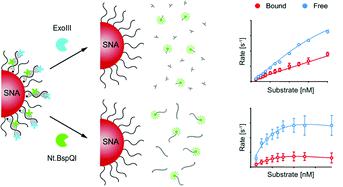Our official English website, www.x-mol.net, welcomes your
feedback! (Note: you will need to create a separate account there.)
Tuning DNA–nanoparticle conjugate properties allows modulation of nuclease activity
Nanoscale ( IF 5.8 ) Pub Date : 2021-2-25 , DOI: 10.1039/d0nr08668a Jeff C. Hsiao 1, 2, 3, 4, 5 , Tomas Buryska 1, 2, 3, 4, 5 , Eunjung Kim 6, 7, 8 , Philip D. Howes 1, 2, 3, 4, 5 , Andrew J. deMello 1, 2, 3, 4, 5
Nanoscale ( IF 5.8 ) Pub Date : 2021-2-25 , DOI: 10.1039/d0nr08668a Jeff C. Hsiao 1, 2, 3, 4, 5 , Tomas Buryska 1, 2, 3, 4, 5 , Eunjung Kim 6, 7, 8 , Philip D. Howes 1, 2, 3, 4, 5 , Andrew J. deMello 1, 2, 3, 4, 5
Affiliation

|
Enzyme–nanoparticle interactions can give rise to a range of new phenomena, most notably significant enzymatic rate enhancement. Accordingly, the careful study and optimization of such systems is likely to give rise to advanced biosensing applications. Herein, we report a systematic study of the interactions between nuclease enzymes and oligonucleotide-coated gold nanoparticles (spherical nucleic acids, SNAs), with the aim of revealing phenomena worthy of evolution into functional nanosystems. Specifically, we study two nucleases, an exonuclease (ExoIII) and an endonuclease (Nt.BspQI), via fluorescence-based kinetic experiments, varying parameters including enzyme and substrate concentrations, and nanoparticle size and surface coverage in non-recycling and a recycling formats. We demonstrate the tuning of nuclease activity by SNA characteristics and show that the modular units of SNAs can be leveraged to either accelerate or suppress nuclease kinetics. Additionally, we observe that the enzymes are capable of cleaving restriction sites buried deep in the oligonucleotide surface layer and that enzymatic rate enhancement occurs in the target recycling format but not in the non-recycling format. Furthermore, we demonstrate a new SNA phenomenon, we term ‘target stacking’, whereby nucleic acid hybridization efficiency increases as enzyme cleavage proceeds during the beginning of a reaction. This investigation provides important data to guide the design of novel SNAs in biosensing and in vitro diagnostic applications.
中文翻译:

调节DNA-纳米颗粒的结合物特性可以调节核酸酶活性
酶与纳米粒子的相互作用会引起一系列新现象,最显着的是酶速率的显着提高。因此,对这种系统的仔细研究和优化可能会导致先进的生物传感应用。在这里,我们报告了核酸酶和寡核苷酸包被的金纳米颗粒(球形核酸,SNA)之间相互作用的系统研究,目的是揭示值得进化为功能性纳米系统的现象。具体来说,我们研究了两种核酸酶,一种是核酸外切酶(ExoIII),另一种是内切核酸酶(Nt.BspQI),通过基于荧光的动力学实验,各种参数(包括酶和底物浓度)以及纳米颗粒大小和非回收和回收形式的表面覆盖率。我们演示了通过SNA特性对核酸酶活性的调节,并表明可以利用SNA的模块单元来加速或抑制核酸酶动力学。另外,我们观察到这些酶能够切割深埋在寡核苷酸表面层中的限制性位点,并且酶速率的提高以靶循环形式发生,而不是以非循环形式发生。此外,我们证明了一种新的SNA现象,我们称之为“靶标堆积”,从而在反应开始时,随着酶裂解的进行,核酸杂交效率会提高。体外诊断应用。
更新日期:2021-02-25
中文翻译:

调节DNA-纳米颗粒的结合物特性可以调节核酸酶活性
酶与纳米粒子的相互作用会引起一系列新现象,最显着的是酶速率的显着提高。因此,对这种系统的仔细研究和优化可能会导致先进的生物传感应用。在这里,我们报告了核酸酶和寡核苷酸包被的金纳米颗粒(球形核酸,SNA)之间相互作用的系统研究,目的是揭示值得进化为功能性纳米系统的现象。具体来说,我们研究了两种核酸酶,一种是核酸外切酶(ExoIII),另一种是内切核酸酶(Nt.BspQI),通过基于荧光的动力学实验,各种参数(包括酶和底物浓度)以及纳米颗粒大小和非回收和回收形式的表面覆盖率。我们演示了通过SNA特性对核酸酶活性的调节,并表明可以利用SNA的模块单元来加速或抑制核酸酶动力学。另外,我们观察到这些酶能够切割深埋在寡核苷酸表面层中的限制性位点,并且酶速率的提高以靶循环形式发生,而不是以非循环形式发生。此外,我们证明了一种新的SNA现象,我们称之为“靶标堆积”,从而在反应开始时,随着酶裂解的进行,核酸杂交效率会提高。体外诊断应用。









































 京公网安备 11010802027423号
京公网安备 11010802027423号